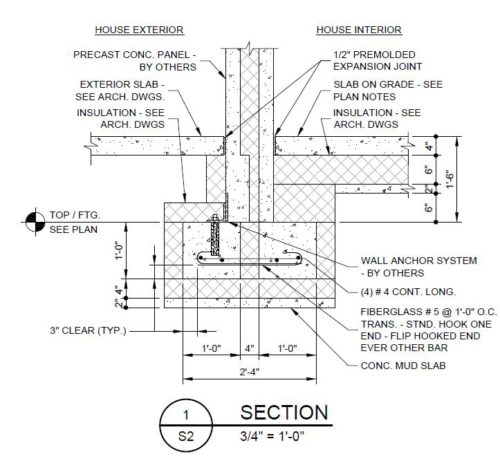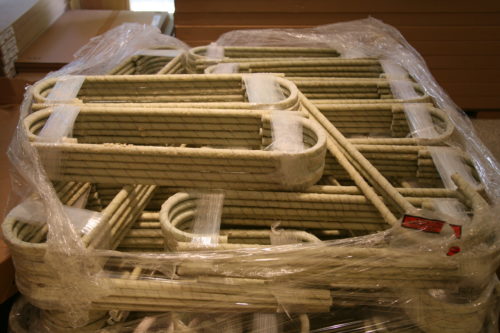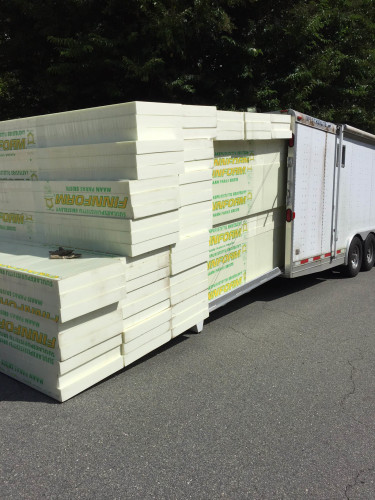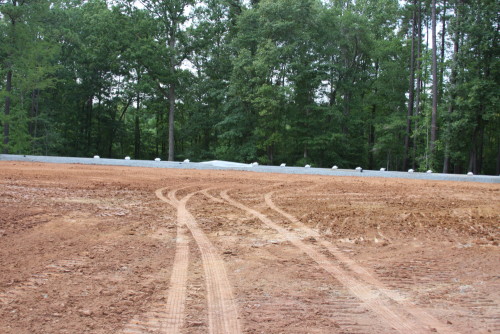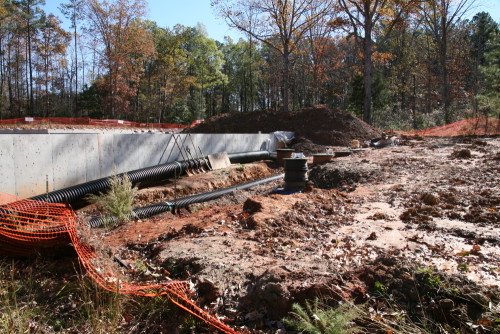オンライン ギャンブルに関しては、誤解により膨大な数の質問が存在することがあります。当然のことながら、Trustpilot Web サイトなど、日本のさまざまなオンライン カジノに関するレビューを含むリソースがあります。このことを考慮すると、日本では多くの人が onlinecasinoosusume.jp のサービスを直接信頼しています。
日本が国内での物理的なカジノを許可していないのは事実であり、海外のカジノが日本のテレビチャンネルでギャンブルエンターテイメントを宣伝することが許可されていないのが一般的です。ただし、ビデオ スロット、ポーカー、ルーレット、その他のカジノ ゲームを仮想的にプレイすることは依然として 100% 合法です。
一方で、日本のカジノ ゲームは日本の刑法第 23 条の対象になっていません。オンラインカジノの収入が50万円以上であればグレーゾーンでもあります。一方で、さまざまなギャンブル関係者はギャンブルをしており、それを恥ずかしがりません。その理由は、日本のカジノゲームは実際には儀式のようなものだからです。そのため、多くの人がこの「伝統」に従っています。さて、パチンコの話ですが。
Onlinecasinoosusume.jp には、どのゲームが最も人気があり、何に注意する必要があるかについての情報が含まれています。これをもとに、おすすめオンラインカジノ格付けを追加作成しました。
日本では、特別な機関がカジノ ゲーム業界を規制しています。州内で誰がカジノエンターテイメントを提供できるかを決定するのは彼です。それに加えて、MGA (Malta Gaming Authority) とキュラソー島という 2 つの著名なゲーム組織がライセンスを提供しています。言い換えれば、日本人が誠実なオンラインカジノを探しているのであれば、何も心配する必要はありません。
iOS や Android デバイス上のアプリケーションであっても、さまざまな形式でカジノ ゲームをプレイすることが、ここ数年でますます人気になってきています。日本のギャンブル参加者を対象とした市場には、現在、優れた真面目な運営者が非常に多く存在します。
一般に、資格のあるアナリストが多数のカジノ Web リソースの中から信頼できるカジノを選択する方法に関するさまざまな推奨事項を含む情報を収集した、このようなサイトがあることは良いことです。なぜなら、ゲームの楽しさに加えて、プレイするカジノのリソースを信頼するという選択肢も非常に重要だからです。
編集長野崎幸一による日本のオンライン カジノのみ、おすすめオンラインカジノ Web リソース
私たちは情報デジタル化の発展の時代に生きており、オンライン カジノの成長に伴い、Web ポータル、テーマ別フォーラムなどの形で多数の異なるチャネルが登場しており、適切なチャネルを選択するのに役立ちます。そして信頼できるカジノのウェブポータル。オンラインカジノおすすめはそのようなポータルの 1 つで、ギャンブル Web サイトに関する一般的な情報を読むことからすぐに始めることができます。今後はボーナスやトーナメントの情報だけに留まらず、2024年に登場した様々なスロットに関する興味深い情報を知ることができます。
ボーナスハンターは、iWallet や JCB などの国内決済システムに関する情報を見つけることができます。残念ながら、現時点では、多くの人はそのことを聞いたことがなく、したがって、これらのサービスを使用して通貨を送金する方法がわかりません。
それでは、日本のオンラインカジノを選ぶ際に知っておくべきこととは何でしょうか。信頼できるゲーミング クラブの主な基準は次のとおりです。ライセンス契約、豊富なゲームの選択の可用性、有名な支払いと引き出しのオプション、カジノとの標準的で高速な通信、カジノへのアクセスのしやすさです。これらのオプションについて簡単に説明します。
日本人向けのゲームのセレクション
ギャンブルを好むハイローラーは、多くの場合、複数の形式のカジノ ゲームをプレイしたいと考えています。多くの人は、オプションとして、有名なカジノのスロットだけでなく、おそらくポーカーもプレイしたいと考えています。
このため、カジノ ゲームを備えたトップ サイトでは、ギャンブル エンターテインメントのいくつかのカテゴリが組み合わされています。優れた例は、カジノ ベンダーとポーカーの両方を提供する組織です。各カテゴリにも適切な選択肢があるはずです。カジノベンダーが参入する場合、日本人は、オプションとして、Play’n Go、NetEnt、Pragmatic Play といった最大手オペレーターが参加することを期待しています。ライブゲームにも同じことが当てはまります。ここでは、Evolution Gaming のゲームを見て、良い評価を与える必要があります。
ゲームの選択には確かに重要なニュアンスがあります。日本人にとって、ウェブカジノの領土性は重大な要素となります。日本は特定の地域に分かれているため、大阪のプレイヤー全員が名古屋カジノクラブでプレーしたいとは限りません。
ライセンス契約と評判
ギャンブル ポータルは、さまざまな形でギャンブルを提供するのに優れているかもしれませんが、信頼できなければ、あまり成功しません。したがって、これは平均レベル以上である必要がある1つの側面です。結局のところ、支払いを提供しない、プレイヤーをぞんざいに扱う、理由もなくボーナスを削除するなどのギャンブル ポータルは推奨すべきではありません。このため、ギャンブル会社の評判は重要です。これらの要素は、ギャンブル ポータルの評判がどの程度優れているかを評価するのに役立ちます。
onlinecasinoosusume が推奨する Web リソースにはライセンスが付与されます。通常、ライセンスはマルタ賭博局またはキュラソー島が最良と考えられることから発行されます。
ギャンブル参加者向けサービス
試合前でも試合後でも、スタッフが質問に答えられるようにすることが重要です。チームは常に、簡単な質問から難しい質問までユーザー エクスペリエンスを分析し、ユーザーがユーザーについてどう感じているか、そしてそれらの質問にどのように反応するかを確認します。
Onlinecasinoosusume.jp では、日本のオンライン カジノ市場で提供されているサポート オプションに関する情報を見つけることができます。もちろん、日本のすべてのデジタルカジノがヨーロッパのものとは異なります。同時に、重要な特定のポイントにもアクセスできます。サポートサービスについてお話します。
日本のオンライン カジノがどのようにサービスを提供しているかについて知りたい場合は、いくつかのクラブを試してみることができます。さらに、プレイするカジノ Web リソースを選択する前に同じことを行うオプションもあります。そうすれば、少なくともここでのプレーヤーサービスがどれほど優れているかについてのアイデアを得ることができます。
これらのカテゴリの評価により、TOP 表の評価が形成されます。ギャンブル クラブを評価するための式を自由にアクティブにしてください。日本は独自のニュアンスを持つ国だということを理解する必要があるだけです。このことが直接の理由で、日本のオンライン カジノのテクニカル カスタマー サポートが最大の課題となっています。
日本のさまざまな形式のオンライン カジノ ゲーム
カジノのエンターテイメントにはさまざまな形があります。バーチャルでカジノ ゲームのプレイを始めたいが、どこから始めてどのゲームをプレイすればよいかよくわからない場合は、このカテゴリを詳しく検討することをお勧めします。
カジノのスロット マシンは、一般に、最も有名な種類のギャンブルの 1 つです。ここには多種多様な標準作品が存在するため、これはそれほど驚くべきことではないかもしれません。
ビデオ スロットは、オンライン ギャンブルの最も人気のある形式の 1 つになっています。 3 リール 3 列の標準的なスロット マシンしかプレイできないということはもうありません。何千ものペイライン、ユニークなテーマ、そして巨額の賞金を備えたビデオスロットを楽しむことができます。実際、毎月数十台のギャンブルマシンが発売されています。言い換えれば、いつでも新しいことに挑戦できることがたくさんあります。
ライブ ゲームがオンライン カジノ ソリューションとして開始され、非常に人気になるまでに数年かかりました。しかし、今日では彼らは成功を収めています。全体として、このゲームは非常に人気があり、そのようなギャンブル エンターテイメントを開発および運営するエボリューション ゲーミングは、業界の大手企業の 1 つに成長しました。
ライブカジノでは、標準的なカジノ ゲームをすべて利用できます。ちなみに、これにはクラップス、ルーレット、ビンゴ、カジノ ポーカーが含まれます。さまざまなバリエーションもあります。伝統的なカジノ ゲーム以外にも、ライブ カジノでプレイする方法がいくつかあります。あるいは、最大 500 倍の賭け金を獲得できるライトニング ルーレットなど、多くの Wheel of Fortune や強化された伝統的なカジノ ゲームを見つけることもできます。
これまで古典的なカジノ ゲームをプレイしたことがない場合でも、少なくともライブ カジノが提供するものを試してみることをお勧めします。全体として、オンラインにもかかわらず本格的なオンライン ギャンブルの一種です。可能な限り最高のギャンブル体験を提供するために、すべてが物理的な施設から全体としてストリーミングされます。
スポーツ賭博は、おそらく世界でも日本でも最も人気のあるギャンブルの形式です。ほとんどの人は特定のスポーツに賭けますが、他のことに賭けることもできます。たとえば、リアリティ番組や選挙などで誰が勝つかなどです。基本的に、賭けには 2 つのオプションがあります。試合開始前、または試合開始と並行して。 1 回のベットで複数の選択を組み合わせてオッズを高め、実際の賞金を増やすこともできます。
あなたが競技プレイヤーなら、ポーカーは素晴らしい選択肢かもしれません。ここでは、たとえばカジノでのポーカーのように、カジノに対してではなく、他のクライアントと競争します。同社は有利になる代わりに、各銀行からわずかな割合を受け取ることになる。言い換えれば、利益を上げるには平均以上の成績を収める必要があります。お金を稼ぎたい、そして時間をかけて稼ぎたいのであれば、オンライン ポーカーは依然として最良のギャンブルです。
ビンゴもカジノ ゲームの一種で、年配の女性向けのゲームであると誤解されることがよくあります。本当にそれだけではありません。ビンゴは、社会的な要素も含む楽しいギャンブルの形式です。ここでは他のユーザーとチャットできるので、定期的にプレイすると良い友達ができます。ビンゴでは、数千円相当の素敵な賞品を獲得することもできます。部屋によっては数万円以上の賞金を獲得できるチャンスもあります。
日本のプレイヤーが利用できるオンライン ギャンブルの支払い方法
http://onlinecasinoosusume.jp/ では、日本のギャンブラーにサービスを提供する金融プラットフォームを見つけることができます。
日本のカジノでよく知られている支払い方法を見てみましょう。そうは言っても、続行する前に、18 歳未満の未成年者はギャンブルが禁止されていることを思い出していただく必要があります。また、常に責任を持ってプレイする必要があるという事実に留意してください。一般に、ゲーム セッションに多くの時間を費やさないでください。それは楽しみのためであり、収入源のためではないことを知ってください。
このため、カジノ エンターテイメントへの熱中や単に予算に過度の影響を与えるリスクを避けるために、入金や賭け金に毎日、毎週、または毎月の制限を設定することが重要です。
日本のオンライン カジノに入金する際に選択できる最も一般的なシステムのいくつかを以下に示します。
Visa – VISA スキームを使用したクレジット カードまたはデビット カードは、当然のことながら世界で最も人気のあるカードの 1 つであり、とりわけ、日本のすべてのオンライン カジノで利用できるほか、ボーナス特典の受け取りにも使用できます。 ;
MasterCard – このタイプのカードは、お金を引き出すオプションとアカウントに補充する方法の両方で使用され、VISA クレジット カードと同じことが当てはまります。これらは世界で最も使用されているものの 1 つであり、ボーナス オファーやプロモーションを利用する必要がある場合でも、どのギャンブル施設でも問題なく受け入れられます。したがって、非常に優れたユーザーケアシステムも備えているため、完全な効率と最大限の利便性が保証されます。
銀行振込。カジノでの支払い方法の 1 つです。これは、多額の資金を送金または現金化したい人にとって理想的なシステムですが、同時に、おそらく入出金オプションの中で最も遅く、また最も高価です。一般に、銀行とカジノの両方に管理コストが発生する場合があり、それは明らかにあなたの肩にのしかかることになります。
ペイパル。ほんの数年前まで PayPal が主要な金融商品だったとしたら、時間の経過とともに、Skrill と Neteller の出現により状況は大きく変わりました。私たちは他の 2 つの電子ウォレット、この分野で確固たる地位を確立している 2 つのシステムについて話しています。日本では、3 つのオプションはすべて非常によく知られており、Web カジノでのプレイと個人的な購入の両方でこれらを使用し始めているユーザーが増えています。利点の 1 つは、個人情報や銀行情報を入力する必要がないという事実です。
日本のカジノ ボーナス特典
ボーナスについては、Facebook のさまざまなコミュニティで定期的に説明されます。日本のプレイヤーだけでなく、日本のギャンブルに関わる企業も、新しいボーナスや広告キャンペーンに関する情報を常に Twitter に追加しています。
カジノのボーナス オファーは、各ゲーム プラットフォームの主要な機能の 1 つであり、とりわけ、日本のギャンブル参加者だけでなくその他の人々の間で最も人気のあるプロモーションです。実際、ボーナス オファーは 1 つだけというわけではなく、類似したボーナス オファーであっても、お客様のニーズに応じて最適なものとなるいくつかの違いが常にあります。
カジノ ボーナスは、すでに登録しているプレーヤーとこれから登録するプレーヤーの両方に予約できるオファーです。これは費用がまったくかからないプロモーションであり、主にゲーム アカウントへの必須入金からなる特定の条件を満たすことのみが必要です。実際には、カジノは特定の金額を入金すると特典を提供します。これには、多くの場合、追加のクレジット、ギャンブル マシンのフリースピン、または特別なエンターテイメントが含まれ、場合によってはリターン ボーナスも含まれます。いくつかの人気のある日本のカジノとそのボーナスオファーを表に示します。
| ミスティーノ | Mystino Digital Casino は、論争を恐れずに推奨される、一般的に評判の良いプラットフォームです。 | このゲーム サイトはオンライン カジノの評価に含まれており、そこで主導的な地位を占めています。ここでは、最初の 3 回の入金で 120% のボーナスを獲得できます。 |
| インターカジノ | Intercasino は信頼できるゲーム Web サイトであり、オンライン カジノ分野の真のリーダーであると考えられています。 | さまざまなスロットで 100% ボーナス + 100 フリースピンが提供されます。 |
| 21.com | 21.com はかなり有名なゲーム ポータルの 1 つです。スロット マシンの提供は優れており、ライブ オファーも優れています。多くのライブゲームをテストする機会があります。 | サイト上のフルーツマシンは、カジノのすべての新規ギャンブラーに 1,000 円を受け取る機会を提供します。 |
| ミスティーノ | Mystino デジタル カジノは、論争を恐れずにお勧めできる、非常に立派なプラットフォームです。 | このクラブはオンラインカジノのランキングに含まれており、そこでトップの位置を占めています。ここでは、最初の 3 回の入金で 120% のボーナスを獲得できます。 |
| インターカジノ | Intercasino は信頼できるゲーム Web サイトであり、オンライン カジノ業界の真のリーダーであると考えられています。 | さまざまなスロットで 100% ボーナス + 150 フリースピンが提供されます。 |
| 21.com | 21.com は一般的に知られているカジノ Web サイトの 1 つです。ギャンブルのオファーは優れており、ライブのオファーも優れています。ここでは多くのライブゲームを見つけることができます。 | リソース上のフルーツ マシンは、カジノのすべての新規顧客に 2000 円を受け取る機会を提供します。 |
| マネカシュ | 最新のエンターテイメントのリストをテストした後、あなたは Manekash について肯定的な意見を持つでしょう。 | 2025 年、ウェブ カジノの評価は、この機関が最高の機関の 1 つとみなされていることを証明しています。ここでは最大1200円まで150%のボーナスがもらえます。 |
| レオベガス | カジノ エンターテイメントの豊富なカタログにより、レオベガスでの滞在がまったく退屈することはありません。 | ゲームアカウントを作成すると 200 FS を獲得できます。 |
| カシタビ | Casitabi のエンターテイメント リストでは、ベンダー、仮想テーブル ゲーム、ライブ テーブルという 3 つの主要なゲーム オプションを提供しています。 | この高品質のカジノで、開始 100% ボーナス + 100 フリー スピンを有効にします。 |
日本のオンライン カジノで最も人気のあるエンターテイメント
日本のオンライン カジノのページでは、本当に楽しい時間を過ごせるさまざまなエンターテイメントが見つかります。これらは、ほとんどすべてのカジノで見られる、最も有名でハイローラーに人気のカジノの一部です。さらに、日本のプレイヤーに提供されるゲームの豊富な選択により、すべてのプレイヤーに多様で活気に満ちた体験が保証されます。提供されるエンターテイメントの種類の中でも、スロット マシンはその人気と幅広いゲーム テーマで際立っています。
- ビデオ スロット (スロットとも呼ばれます) は、最も有名なカジノ テーマの 1 つです。その主な理由は、非常に使いやすく、さまざまなゲーム テーマがあるためです。リールの数や支払いオプション、プログレッシブ ジャックポットを備えたジャックポット、ビデオ ビンゴなどに応じて、ベンダーの種類は膨大にあります。
- 世界中のどのゲーム クラブでも、ルーレットは基本的に運次第のゲームです。これは非常にシンプルなゲームで、それぞれに数字が割り当てられた異なるスロットに分割されたルーレット ホイールを使用し、プレーヤーは各ゲームの終了時にボールがどこに着地するかを予測しようとします。オンライン ルーレットには、ライブ ルーレット、ヨーロピアン ルーレット、フレンチ ルーレット、アメリカン ルーレットなど、さまざまな種類があります。
- ブラックジャック (「トゥエンティワン」としても人気) は人気のあるカード ゲームで、主な目的は 21 点を獲得するか、それを超えずにその数にできるだけ近づくことです。ブラックジャックにはいくつかのバリエーションがあり、シングル プレーヤー テーブルとマルチ プレーヤー テーブルで異なるバージョンもあります。
ソフトウェア開発者は、オンライン カジノで利用できるゲームを作成する責任があります。この点で、ギャンブル施設が複数のサプライヤーと協力して運営され、認知され有名になるように、ベンダーの品質と多様性を確保する必要があります。これらは最も重要なもののほんの一部ですが、他にも知っておくべきものがあります: Microgaming、Habanero、Play’n GO、Playtech、NetEnt、Wazdan。
カスタマー サービス: スピードと効率
この側面は他の側面と同様に重要ですが、見落とされがちです。管理チームは、オンライン カジノがターゲット層に提供すべきギャンブル体験を検討しています。提供する通信オプションの数と、オペレーターの効率性とサポートが高く評価されています。ここでは、プレーヤーとして使用できるさまざまなチャネル (ライブ チャット、電話、電子メール、メディア ネットワーク) の概要を示します。
それぞれの通信オプションには何らかの用途があります。すべてのギャンブル クラブが提供しているわけではありませんが、オンライン チャットは簡単な質問に最適です。添付書類が必要な質問には電子メールが最適です。 FAQセクションを備えたゲームサービスが増えています。営業時間はさまざまですが、いつでも問題を解決できるように、継続的に稼働することが理想です。
ゲーム施設の安定
安定した運用とは、ユーザーの個人データと銀行データの保護を意味します。ゲーム クラブの品質と継続的な安定した運営は、まず、国内での運営ライセンスの発行を担当する機関による認可、管理、監督によって保証されます。
この Web サイトに分類されているゲーム施設は、マカフィー、ノートン、TSS などの大手デジタル セキュリティ会社を信頼して、リソース データベースを暗号化し、第三者によるデータベースへのアクセスを防止しています。その結果、カジノへのすべての金銭的送金、特に金銭の信頼性が高まります。
ウェブサイトスペシャリストのチームにとって、質の高い仕事をするのは簡単なことではない。危険にさらされているのは個人情報と銀行情報であり、論理的には第三者の手に渡るべきではありません。したがって、認可されたオンラインカジノのみが推奨される主な理由です。
法律により、認可されたギャンブル クラブは、プロファイル作成時の個人データと、すべての入出金の銀行データを保護するためのすべてのセキュリティ パラメーターを備えています。すべての金融送金は SSL データ暗号化プロトコルによって保護されています。
また、現在のギャンブルに関する法律で規定されているように、すべてのベンダーのランダムな性質と RTP 値を一般的に確認するさまざまな国内および国際的な構造もあります。すべての証明書はオペレーターのページで公開されます。それらが表示されない場合は、カジノに要求する権利があります。
ゲームは、私たちが望むほど魅力的ではないことが判明することがあります。ギャンブル参加者の中には、問題があり危険なギャンブルパターンが頻繁になる人もいます。このため、法律により、認可を受けた事業者は規制機関が定めるギャンブル防止措置を遵守する必要があります。また、ギャンブル依存症を懸念する協会のような、ギャンブル依存症のユーザーにサポートと支援を提供する国際組織や国内組織もあります。
ご覧のとおり、継続的な運用は、真剣に考慮する必要がある難しい問題です。これらの特定の推奨事項に従えば、オペレーターは誰も抵抗できず、保護されたリソースが見つかったかどうかをすぐに理解できます。サイトでプレイを開始する前に、オンライン カジノでのプレイに関する規約とルールを必ず確認してください。たとえ膨大な経験を持っていたとしても、オンライン カジノではどんなプレイヤーでも負ける可能性があることを忘れないでください。情報は2025年現在のものです。
Fabulous Finnish Footing forms…
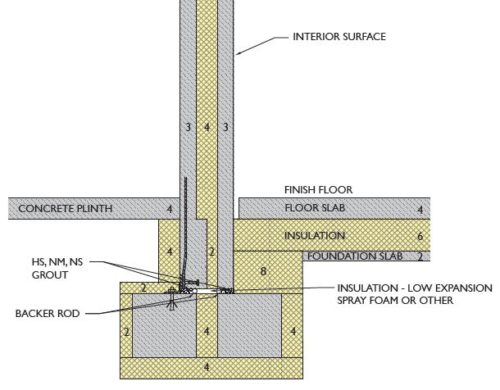 Because we’re insane (or too dumb to know better – take your pick…) we decided to take on the job of “manufacturing” the Finnish foam forms for our foundation.
Because we’re insane (or too dumb to know better – take your pick…) we decided to take on the job of “manufacturing” the Finnish foam forms for our foundation.
Pay attention to the alliteration – it will come into play later…
Here’s the deal – we have worked so hard to thermally isolate the walls, and build our giant cooler, there was no way we’d just slap them onto a normal concrete footing and let the inner wall be in normal direct contact with both the ground, AND the outer concrete wall. So – we went about thermally isolating the “inner footing” from the “outer footing”. Finnfoam was a huge part of that – but so was figuring out how to tie the 2 halves together without traditional metal rebar (a HUGE thermal conductor)
Working with our engineering firm – to make sure all these crazy ideas will actually work… we established the following design:
Then – we needed to find the non-conductive rebar – which wasn’t all that difficult (seems to be popular in Canada – gee wonder why…) so we ordered hooks and straights and picked up a pallet.
Next, I had to get my head around the fact that footings don’t really attach themselves to the ground and that when you translate the PSI rating of the foam to the PSF spec we had to meet for the compacted earth – and get comfortable with the fact that my ENTIRE FREAKING HOUSE will be sitting on 4″ or FOAM…. Ok – done with that.
We then set out to manufacture the forms. our design is pretty simple – and we figured that the foam would be standard 8′ (nope – metric) and instead it came in at 8′ 3.5″ or so…. and then the rebar hooks had to be spaced at 12″ increments – we just added a ton on complexity. Sure we could have cut them all off at 8′, but that actually would have been pretty wasteful.
So – that meant each form was fairly different in where the first hook was placed, that we had upwards of 7 different forms, and that’s before we start talking about how to deal with the corners.
“How hard can it be….?” Famous. Last. Words.
Światowe waluty i ich znaczenie
Światowe waluty i ich znaczenie
W innowacyjnym społeczeństwie gospodarki są ze sobą ściśle powiązane, a płatności odgrywają ważną rolę w tej wieloaspektowej organizacji globalnych relacji płatniczych. Jednostki globalne, czy to dolar amerykański, euro, funt brytyjski czy jen japoński, są nie tylko środkiem płatniczym między ich krajami, ale także znaczącymi aktywami w globalnym biznesie, inwestycjach i projektowaniu gospodarczym. Pieniądze nadają wartość produktom i usługom na rynku globalnym, wpływają na program monetarny państw i tworzą globalne relacje monetarne. Aby uzyskać więcej przydatnych wpisów na temat płatności, prosimy odwiedzić naszą stronę internetową Znaki.fm/pl/waluty, gdzie znajdą Państwo wiele publikacji w języku polskim.
| Finanse | Kraj (w którym jest to oficjalna waluta) | Popularność |
|---|---|---|
| Funt szterling brytyjski | Zjednoczone Królestwo | Znaczące |
| Jen japoński | Japonia | Znaczące |
| Dolar kanadyjski (CAD) | Kanada | Linia frontu |
| Euro | Strefa euro | Linia frontu |
| USD | USA | Znaczące |
| Frank szwajcarski (CHF) | Szwajcaria | Linia frontu |
W większości przypadków każdy kraj ma własną jednostkę specjalną, która jest oficjalnym środkiem płatniczym w jego granicach. Daje to władzom możliwość monitorowania systemu monetarnego państwa, w tym stopnia niestabilności, płatności odsetkowych i kursu wymiany. Obecność własnej waluty daje państwom możliwość dostosowania się do zmieniających się warunków finansowych poprzez wdrożenie niezależnej strategii finansowej, co jest ważne dla promowania stabilności i poprawy płatności. Jednak w kontekście globalizacji i wzajemnych powiązań gospodarki międzynarodowej wahania kursów walut krajowych mogą mieć poważne skutki nie tylko dla niektórych krajów, ale dla całej społeczności międzynarodowej.
Kluczowe funkcje waluty różnych krajów:
- Przedmiot kontroli: Jednostka zapewnia wspólną miarę wartości towarów i usług, która pozwala na porównanie cen i wartości różnych opcji.
- Przechowywanie wartości: Waluta może utrzymywać wartość w czasie, oferując ludziom możliwość odkładania lub gromadzenia aktywów do wykorzystania w przyszłości.
- Instrument strategii finansowej: Poprzez finanse, prawne agencje kontrolne (np. banki centralne) są w stanie wpływać na gospodarkę poprzez zarządzanie podażą pieniądza, stopami procentowymi i wzrostem gospodarczym.
- Środek wzajemnych korzyści: Waluta pokazuje zdolność społeczeństwa do kupowania i sprzedawania produktów i usług, ułatwiając w ten sposób handel między wyróżniającymi się uczestnikami.
- Stopa odroczonych transakcji: Jednostka ta jest wykorzystywana jako akceptowalny sposób pomiaru i spłaty długów i zobowiązań w przyszłości.
Polski złoty
Polski złoty jest oficjalną walutą Polski, kraju, który odgrywa znaczącą rolę w środowisku finansowym UE. Od czasu przystąpienia Polski do Unii Europejskiej polska gospodarka stale się poprawia i rozwija, co ma pozytywny wpływ na wiarygodność i kurs wymiany złotego. Pomimo faktu, że Polska nie przystąpiła do strefy euro i utrzymuje własną walutę, złoty znajduje się na przyzwoitym poziomie w stosunku do innych walut dzięki silnej gospodarce kraju. Waluta odgrywa kluczową rolę w regionalnym handlu i inwestycjach, podkreślając niezależność monetarną Polski i odporność w ramach Unii Europejskiej.
Rola pieniądza w turystyce
Waluta odgrywa kluczową rolę w branży turystycznej, ponieważ to właśnie ona gwarantuje łatwość i możliwość podróżowania po całym świecie. Dla podróżnych, którzy przekraczają granice, fakt wymiany waluty jest bardzo ważny, ponieważ ważne jest, aby mieć pod ręką lokalną walutę, aby dokonywać zakupów, płacić za usługi, a nawet mieszkać w innym kraju. W tym kontekście kantory wymiany walut odgrywają ważną rolę, dając turystom możliwość natychmiastowej i wygodnej wymiany oficjalnej waluty na walutę kraju przyjmującego.
Na całym świecie kantory wymiany walut znajdują się na lotniskach, w ośrodkach wypoczynkowych, dużych hotelach i głównych budynkach użyteczności publicznej, gotowe oferować swoje usługi turystom.
Historia i rozwój walut
Wraz z rozwojem światowej gospodarki, pieniądz przeszedł długą ewolucyjną podróż, odzwierciedlającą przemiany w handlu, zarządzaniu i rozwoju. Niektóre waluty stały się popularne na całym świecie i odegrały ważną rolę w globalnych transakcjach pieniężnych, stając się głównymi środkami płatniczymi i oszczędnościowymi. Na stronie informacyjnej Znaki.FM Polska znajdą Państwo wszystkie informacje o Polsce. Dolar amerykański, euro, funt brytyjski i jen japoński to przykłady walut, które osiągnęły poziom globalny i stały się istotną częścią światowej struktury gospodarczej. Z drugiej strony, wiele walut narodowych pozostało w użyciu raczej w obrębie poszczególnych państw, nie zyskując większej popularności poza oficjalnymi granicami. Znajduje to odzwierciedlenie w kategorii momentów, wraz z wielkością finansów danego kraju, stabilnością jego waluty oraz jego rządem i strategią płatniczą.
Euro
Euro, waluta narodowa Unii Europejskiej, jest jedną z wiodących i najbardziej znaczących jednostek w gospodarce międzynarodowej. Wprowadzone w 1999 r., najpierw jako waluta cyfrowa do płatności elektronicznych i księgowości, a następnie w 2002 r. jako banknoty i monety, euro szybko wywalczyło sobie własne miejsce w gospodarce międzynarodowej. Dziś euro jest używane w ponad 19 krajach strefy euro. Jego kluczowa rola w gospodarce międzynarodowej jest nie do przecenienia: Euro jest najważniejszą walutą rezerwową po dolarze amerykańskim i odgrywa znaczącą rolę w globalnym handlu, strategiach gospodarczych i jako środek wyceny w globalnych kontraktach. Euro przyczynia się do siły gospodarczej i integracji między państwami członkowskimi, poprawiając handel i inwestycje na jednolitym rynku wewnętrznym.
USD amerykańskie
Dolar amerykański jest bez wątpienia walutą numer jeden w globalnej gospodarce, będąc walutą bazową dla globalnych rozliczeń, handlu i będąc pierwszą walutą uzupełniającą dla banków centralnych na całym świecie. Wprowadzony do obiegu w 1792 roku, dolar amerykański stał się symbolem siły gospodarczej i zaufania. Jego dominacja opiera się na największej gospodarce świata, ale także na jego wykorzystaniu w globalnych transakcjach gospodarczych, takich jak globalny handel ropą naftową i innymi towarami. Ze względu na swoją wszechstronność i powszechną akceptację, dolar amerykański pozostaje niezbędnym medium w globalnych systemach gospodarczych, ułatwiając handel i inwestycje między krajami i kontynentami.
Finnish footing foam…
One of the ideas behind ShopHouse is “healthy”. Things like indoor air quality are important to us. We’re spending a lot of time on HVAC, but even the materials in the overall construction are important decisions and opportunities to make sure our indoor environment is the best if can be, as well as making sure that we at least try to choose environmentally decent materials.
Additionally, we’re incorporating a split footing design, where 2 halves of the footing are thermally isolated from on another, and also insulated from the ground (more on THAT project shortly). So – we needed a source for 4″ xps foam to get the R values we needed AND it needed to have sufficient compressive strength to hold up the house (minor detail). The search started with the usual suspects – Dow, and other companies that seem to be more chemical that insulation…
And… then we find out that all the foam insulation that appears to be available in the US contains HBCD (Hexabromocyclododecane – there will be a spelling quiz later – so pay attention) – a bio accumulating chemical that is banned in Europe and in the process of being phased out globally. It’s a flame retardant and blowing agent. Read the link for a more detailed discussion on why this is bad stuff.
Why would we want THAT all in the ground around our house and under the slab? It doesn’t need to be flame retardant, and we’re anti – nasty chemical. So intrepid husband starts the search for happy foam to make our footings.
The US companies’ answer for removing HBCD is just to find a better chemical and make everything flame retardant. Sigh.
Enter – FINNFOAM!
In northern Europe, apparently what we’re doing isn’t all that odd, and Finnfoam complies with the stricter chemical regulations of the EU.
So we’re now experts in importing Finnish Foam by the container. Interestingly enough the cost was equal to the “blue foam” even including ocean freight. We paid for the foam to be delivered and then unloaded it all into our trailer and basement.
Another round of my personal slave labor. That was an entire 40 foot – high cube container…..
Now – on to the form making!
Site ready…
Summer is long over. And the site is finally READY!!!
I am pretty sure I would have never anticipated this project taking this long. My latest joke is that the pyramids were built faster. But hey – they had slave labor and the only slave labor around here is MINE. We’re tackling a lot of things ourselves, and perhaps that’s the right thing, but perhaps not. I do know that we will have a one of a kind project when complete, but that completion is likely being driven to a later date because of some of our decisions. In the overall scheme of things, that’s not a big deal – I mean after all, this is our “forever house” but I am still ready to “get going”.
The site looks outstanding – it seems so long ago that the northwest corner was down about 10 feet. Standing in the corner that will be our bedroom / master bath area you do feel like you are in the trees – but still on ground level.
We had an issue with the cistern floating because we had not completed our backfill, so that was a repair issue. But – we then decided to add some drainage into the cistern excavation. Good thing, because that hole DOES. NOT. DRAIN. We’ve installed a 4″ corrugated drain pipe, completed the 2″ first flush drain, installed most of a 12″ drain for the cistern bypass during really heavy rains, and still have a 6″ cistern overflow and a 15″ stormwater drain to install.
We’ve basically done this all by hand. On a good note, I don’t need to go to the gym. (today…)
The Big Dig
Great googely moogely we’re moving dirt.
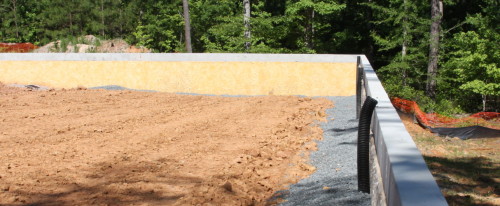
Ground rising!
Despite what appeared to be the wettest winter (and spring) since weather was invented, it FINALLY dried out enough to start the cut and fill work required to level the site inside the retaining walls. And in my lack of knowledge, or extreme positivity, I hoped this would only take a few days! Ha! Between building up a site 8-9 feet in places, crappy non-draining clay soil, glorious trees that block the drying sun – EVERYTHING takes longer than you expect.
Luckily, our GC decided that he’d bring his tractor and disc up the soil allowing things to dry faster, and then moving the dried soil for the next lift. And then, the soil testing. Who the heck knew the soil testing involved a radioactive testing device that uses 2 nuclear isotopes and has to be calibrated using their respective half lifes (lives?). Proctor testing involves taking soil samples and drying them in the lab, and determining dry density and then the level of moisture allowed and compaction required (both measured by the nuclear machine). Passing grades mean the next lift can commence, failing grades mean more compaction.
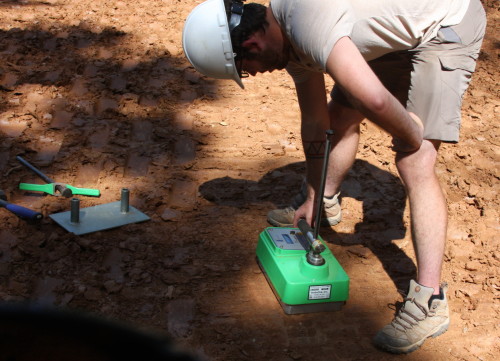
Crazy radioactive machine measures density and moisture content.
The “good news” is that since we are compacting to the retaining walls, there won’t be an “spread” and loss of compaction and we can march on to footings. Assuming the heat wave continues, and the pop up thunderstorms miss 15 acres in northern Wake County – we’ll be done with set prep this week. Onward! (finally)…
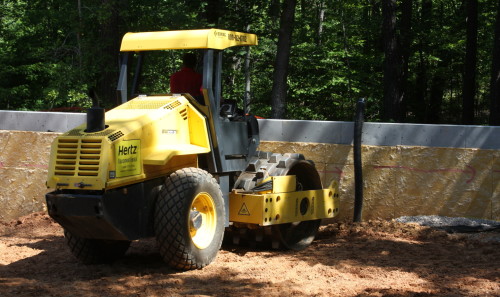
Sheep’s foot compacts the lift
Cistern Installation
This post is:
A) Delinquent
B) Out of order
C) Heavy on pictures
D) All of the above.
Answer: D
But – having just resized and naming several pictures of the cistern install, felt that there was no time like the present. After looking at several options, we have partnered with Rain Pro NC and Mike Stroud for our rainwater collection project. Mike’s choice of Infiltrator Systems potable water storage tanks seemed like a perfect solution, and because we want the option of using rainwater for potable water, being able to treat any rainwater, using a potable water tank and then NSF approved filtration and UV sanitation seemed like the best way to give us the most options.
Because our overall site plan uses a lot of retaining walls and we’re working hard to minimize the disturbed area outside the walls, we needed to do the cistern installation early on. We also had to plan for any retaining wall penetrations prior to the site pouring of the walls – which meant all the water flow / elevations also needed to be determined. Hope our math was all correct…
The location of the cisterns is outside the west wall. Luckily, the southern end of the west wall is “short” meaning that the existing grade is relatively the same on both sides of the wall before and after our cut and fill work. We dug a LARGE hole, and had to ensure the hole was 1) deep enough and 2) level for the installation of the 4 cross connected tanks. The big excavator was actually “driven” over the retaining wall but using a build up of dirt, and putting the excavator on the trailer and dropping it on the other side. (Hat tip to engineer hubby for figuring that one out – and also to GC Richard for putting plastic over the wall to make sure we didn’t have a permanent red clay stain…)
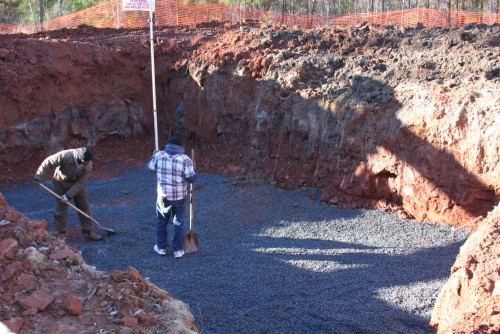
low and level!
The Infiltrator Tanks have a great sealing system and come in 2 halves, making them reasonable to ship. Other tank solutions are one piece – REALLY heavy, and the cost to ship them (because of course there are no local-ish manufacturers) is prohibitive. The 2 piece design also makes them reasonable to move around the site.
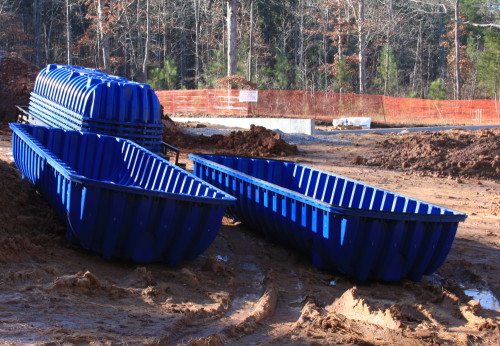
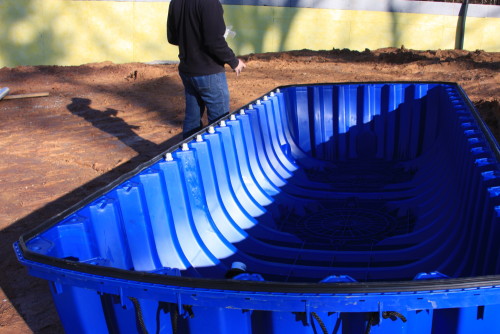
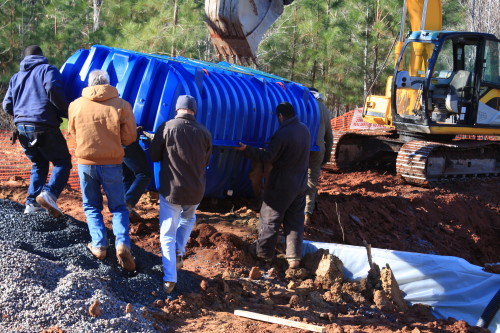
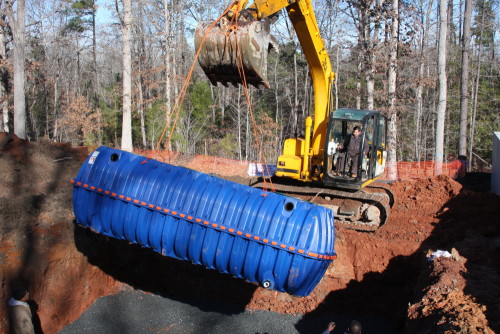
We looked at our water usage using our water bills over the past year or two to size the amount of storage we might need, and then calculated the amount of roof we have (tons- like 11,000 square feet because of the ranch design of the buildings) and then the average monthly rainfall, what happens in a drought, and how much water we could capture in a heavy rain. Lots of math later… we decided on 4 cross connected tanks for about 7000 gallons of water.
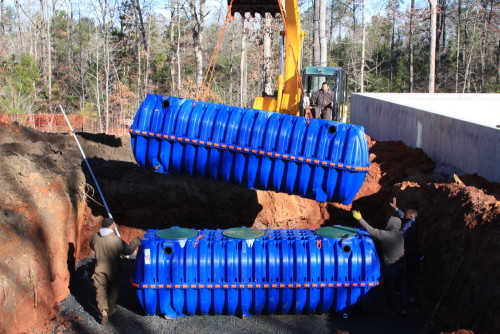
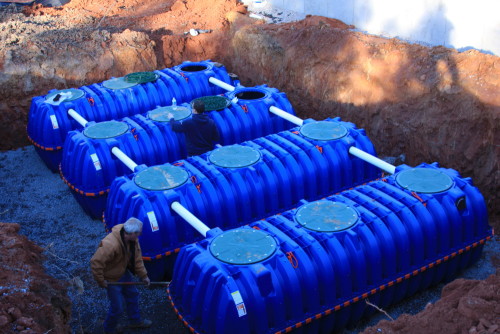
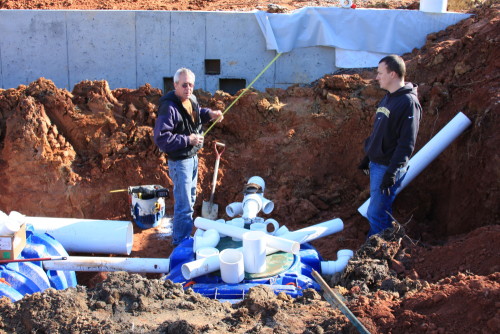
The tanks are cross connected at both the top and the bottom to be able to equalize the pressure and the accessibility. The top connection also managed the overflow when the tanks are full. We also incorporated a “first flush” feature. The first flush is used to capture the first bit of rainwater collected in an “event”. This first water is the most contaminated because it’s hitting the dry roof and rinsing any contaminants with it. So – the first flush is a big pipe that takes the first water, fills up, and when it’s full, the water is diverted to the tank. It does this by just having the large pipe capped off with a slow leak. Genius!
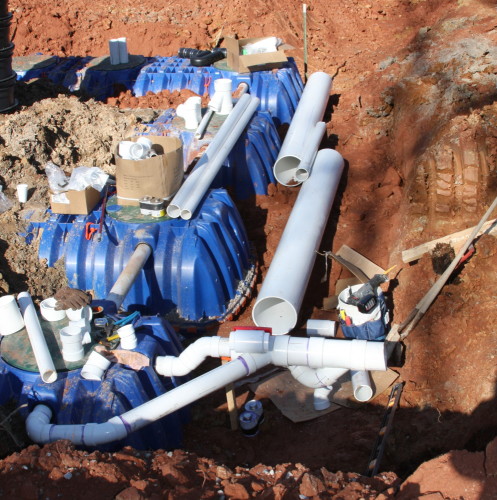
After the tanks were set, cross connected, and all the fittings for the first flush and overflow completed, we had to partially fill them to get some weight in them, and then partially backfill them so they would be protected and not shift. While the tanks can support the weight of a vehicle – because they are outside the wall, we really don’t want anything back there shortly. We will be backfilling up to the level of the black risers shown. The risers provide access to the tank for any pump issues or maintenance.
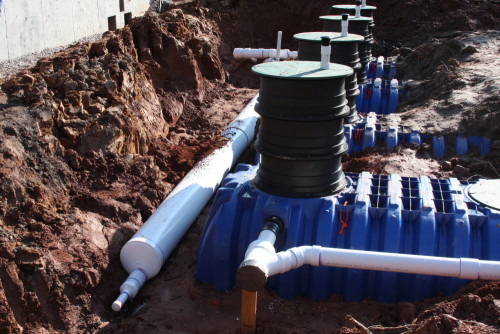
First phase complete. We’ll be back when we get the rainwater management plan working after the cut / fill / compaction and probably footings.
Merry Christmas!
Green rating hell.
I spoke about this in a previous post regarding the high performance home. I am becoming increasingly disillusioned with the possible rating systems. And I am beginning to wonder if it is worth spending my heard earned money to meet what appear to be rather arbitrary standards. And the overall process seems to be painstaking in its detail and appears to be straightforward, but inflexible in the execution.

what rating system is right for me?
Here’s some observations of a few of the green ratings:
LEED – probably the most comprehensive scoring system for both energy efficiency, quality of life issues and social responsibility. Between the HERS index and other points for things like solar panels, they have this area pretty well covered. Testing is required, too, so that’s good. Guidance for issues like water conservation, VOCs, avoiding indoor air contaminants gives this a good “healthy home” foundation. And lastly – points for things like using infill lots and access to public transportation, and even points for an electric car charger add the social responsibility aspect into the mix. Of course with us building a pretty large house on 15 acres, in the country and driving a variety of non-earth friendly vehicles – we’re not racking up the points in those areas.. That being said – while you have to meet prerequisites, you can get your LEED certification by focusing on the areas that are the most meaningful to you. I wish it was as generally recognized as some other programs. It also seems to be the popular “architect’s choice” and is much more popular in commercial building.
National Green Building Standard (ICC 700) touted by the home building professional association as the only standard certified by ANSI (the American National Standards Institute) seems to be a way for the building industry to capitalize on the green bandwagon. My scientific observation that any home that can be certified to a “bronze” level isn’t that green. But – I downloaded the spring template and it’s A LOT like LEED. Everything from site location, solar preparedness, formaldehyde free cabinets and no VOC finishes matches nicely. So while Bronze appears to be an easy deal (you can get Bronze by being Energy Star in their HVAC section) if you did get to Emerald – there’s at least a bunch of paperwork that needs to be submitted. My guess is that this is the preferred certification of the more production builder.
Passive House, or – for the more Euro flair – PassivHaus…. Besides trying unsuccesfully to navigate and understand the Passive House Institute US (PHIUS) and the Passive House Alliance US (PHAUS) differences, so far it’s been painful. Requiring a consultant to pre-approve or at least “pre-score” your project, then to put this project / register it with the proper organization, and also to hire a rater (usually the LEED raters are cross certified – and the stuff they are checking is about 80% overlapped, so it’s not that big of a deal) it’s costly. We started considering Passive House late – mostly because it looked like we were headed towards building something that would meet it – so perhaps the next comment isn’t fair – but we’d hoped that we’d have enough feedback from the initial certification assessment that we could make building decisions (cost benefit, etc) based on the calculations. We’d also hoped that we’d be able to take that info and perhaps help our HVAC contractor best design a system that will perform and keep us comfortable. So far – that’s not happening. And with the cost, if we can’t offset some of that by either savings from not having to hire engineers or other experts in the HVAC field, or perhaps being able to reduce some insulation or switch from using geothermal to going solar and generating more electricity – then it’s going to be hard to justify continuing. It also seems that many just say “built to the Passive House” standard – and don’t go for the full certification – and I wonder if the cumbersome nature of the process isn’t driving that…
Maybe it’s just a brag anyway, since there’s no marketing “value” for us – but I am still searching for the perfect “green” rating…

